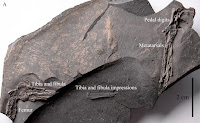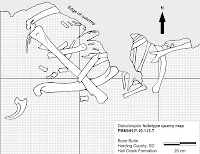The Maniraptorans were a highly diverse and successful group of Theropod Dinosaurs, whose members included the Dromaeosaurs, Troodontids and Birds. For a long while this group was overlooked in favour of more massive Theropod groups, however in recent years this group has been extensively studied, with numerous specimens discovered on several continents, leading to a better understanding of the group's evolution and diversity. Japan has relatively little exposed Tertiary terrestrial sediment, and subsequently has produced few Dinosaur specimens, and less of any great quality. One site known to produce high quality terrestrial fossils in Japan is the Kitadani Dinosaur Quarry in Fukui Prefecture, which has produced numerous Dinosaur remains, as well as Pterosaurs, Crocodyliforms, Turtles, Mammals, Invertebrates and Plants.
In a paper published in the journal Nature Scientific Reports on 23 February 2016, a team of scientist led by Yoichi Azuma of the Institute of Dinosaur Research at Fukui Prefectural University and the Fukui Prefectural Dinosaur Museum describe a new Maniraptoran Dinosaur from the Kitadani Dinosaur Quarry, which is clearly a Maniraptoran, but which does not appear to belong to any known Maniraptoran group.
The new Dinosaur is named Fukuivenator paradoxus, where 'Fukuivenator' means 'Fukui-hunter' and 'paradoxus' refers to the surprising combination of features seen in the specimen. Fukuivenator paradoxus is in many ways similar to a Dromaeosaur, but has a number of feature more typical of other Maniraptoran groups, such as a premaxilla (bone at the tip of the upper jaw) with a broad subnarial shelf and a long maxillary process extending backwards, a feature typical of Ornithomimosaurs, enlarged promaxillary fenestra (paired holes above the jaw in Dinosaurs and other Diapsids), a feature seen in early Troodontids and Birds, a lacrimal bone (bone on the inner side of each eye socket) with a T-shape in profile, another feature associated with Troodontids and at least 11 cervical (neck) vertebrae, a feature otherwise known only in Birds.
Cranial skeletal morphology of Fukuivenator paradoxus. (a) Partial right premaxilla in lateral view. (b) Partial left maxilla in lateral view. (c) Partial left lacrimal in lateral view. (d) Right frontal in dorsal view. (e) Right postorbital in lateral view. (f) Left squamosal in lateral view. (g) Partial right dentary in lateral view. Scale bar is 10 mm. Abbreviations: aofe, antorbital fenestra; en, external naris; mxfe; maxillary fenestra, prfe; premaxillary fenestra. Azuma et al. (2016).
Fukuivenator paradoxus also shows a number of features not seen in any other Maniraptoran Dinosaur, most notably heterodont dentition (different teeth in different parts of the jaw), a feature extremely rare in Dinosaurs and not previously recorded in any Theropod, and unserrated teeth, oval in profile, unlike the serrated blade-shaped teeth of most Theropods.
Premaxillary and maxillary teeth of Fukuivenator paradoxus. (a) Isolated anteriormost? premaxillary tooth in lateral (left) and posterior (right) views. (b) Enlarged view of the crown in (a) lateral (left), anterior (middle), and posterior (right) views. (c) Crown of an isolated left premaxillary tooth in distal (left), lateral (middle), mesial (right) views with an enlarged view of the mesial “ridge” (red box). (d) Intact left maxillary teeth in lateral view. Scale bar is 10 mm for (a,d), 7.5 mm for (b), and 12.5 mm for (c). Azuma et al. (2016).
Azuma et al. suggest that the unusual dentition and long neck of Fukuivenator paradoxus may hold the key to its unusual morphology, and note that other in other Theropod groups the development of unique dentition has been conected to elongation of the neck, and suggests that these features combined probably indicate a move away from a strictly carnivorous diet.
See also...
 Boreonykus certekorum: A new species of Velociraptorine Dromaeosaur from the Late Cretaceous of west-cemtral Alberta. Dromaeosaurs are thought to have been the group of Theropod Dinosaurs
most closely related to birds, making them of great interest to
palaeontologists. They were smal-to-medium sized predatory Dinosaurs,
which all appear to have had extensive featheres plumage...
Boreonykus certekorum: A new species of Velociraptorine Dromaeosaur from the Late Cretaceous of west-cemtral Alberta. Dromaeosaurs are thought to have been the group of Theropod Dinosaurs
most closely related to birds, making them of great interest to
palaeontologists. They were smal-to-medium sized predatory Dinosaurs,
which all appear to have had extensive featheres plumage...  Partial Dromaeosaur remains from the Early Cretaceous of Inner Mongolia. Dromaeosaurs are thought to have been the Dinosaur group most closely
related to the earliest Birds, making them of great interest to
palaeontologists...
Partial Dromaeosaur remains from the Early Cretaceous of Inner Mongolia. Dromaeosaurs are thought to have been the Dinosaur group most closely
related to the earliest Birds, making them of great interest to
palaeontologists... Dakotaraptor steini: A giant, feathered Dromaeosaurid from the End Cretaceous Hell Creek Formation of South Dakota. Dromaeosaurids were first
described in the 1920s, but received relatively little attention from
palaeontologists until the late 1960s. However in recent years it has been
realized that the group were...
Dakotaraptor steini: A giant, feathered Dromaeosaurid from the End Cretaceous Hell Creek Formation of South Dakota. Dromaeosaurids were first
described in the 1920s, but received relatively little attention from
palaeontologists until the late 1960s. However in recent years it has been
realized that the group were...
Follow Sciency Thoughts on
Facebook.


